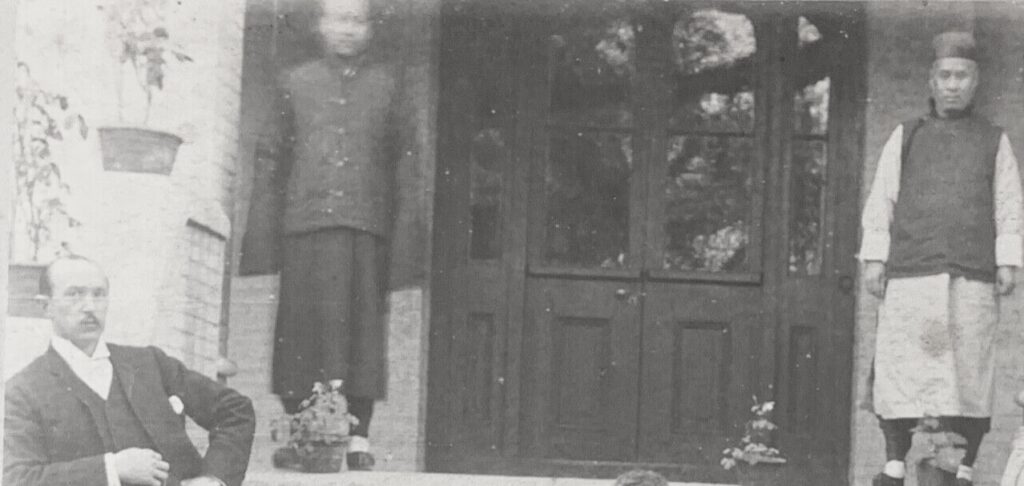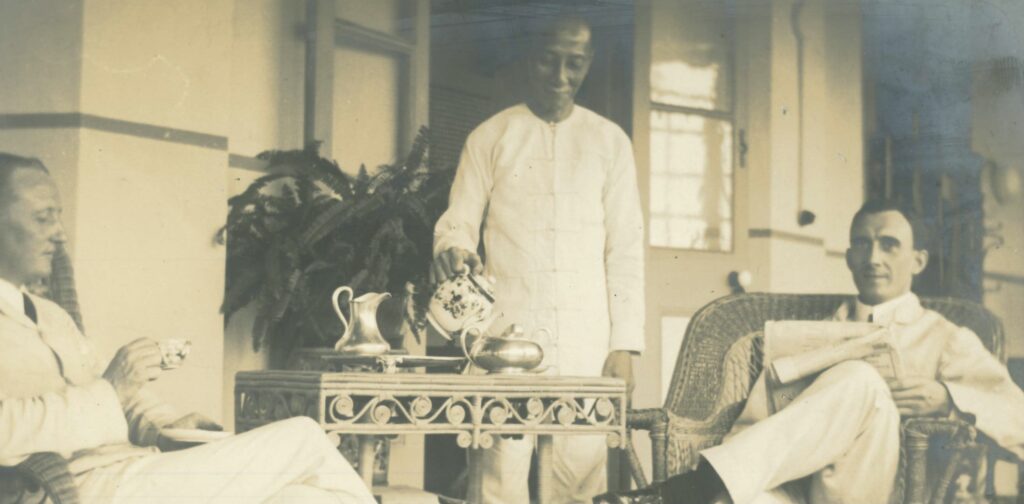If a caption is needed for the featured image above, it would be: “Boy, go catchee two piecey tea.” Where is the “boy”? It is the man standing in the middle of the photograph. Although his appearance suggests a rather mature age, he was designated the “boy” back in the 19th and 20th centuries. Such usage, according to the Hobson-Jobson dictionary, was common in Southern India and China to refer to a personal servant. “Boy” can also be a vocative, as in the caption of the photograph.1 Different types of servants could be found in European families settling in China in the 19th century. As in India, these families might employ as many as a dozen servants to run their households. Carl Crow, a long-time resident in China, praised the Chinese servants, describing them as “patient and industrious and loyal”. Employers often found themselves spoiled by the servants because they made sure that everything in the house was orderly, and most importantly they were skillful in acquiring “the likes and dislikes of the master and mistress.”2
Europeans coming to the Orient had to quickly learn the customs and people of the environs through direct interactions or guides. One such guide is The Treaty Ports of China and Japan (1867), which provides practical tips and information for readers settling in the two countries. One of the topics they touch on is about hiring servants. The authors note that in Hong Kong “Most of the servants employed by Europeans are of Cantonese origin, and possess a greater or less knowledge of “pidgin English” a queer compound of Anglicised Chinese and Chinese-rendered English, with a few words of Malay and Portuguese origin. A facility in speaking this barbarous jingle of words is a necessary accomplishment for holding communication with the servant class in Hongkong, though of late years the Chinese have improved in this efforts to acquire a correct manner of speaking English.”3 Though brief, the note points out some essential nature of “pidgin English”, or Chinese Pidgin English. Problems and challenges may arise when different cultures are in contact. Language is a major concern because the problems of difference and misunderstanding may aggravate without a common means of communication. The emergence of Chinese Pidgin English in 18th-century Canton (now Guangzhou) was a way to make communication possible. For example, the interaction between the Europeans and the Chinese was likely conducted in Chinese Pidgin English.
Apart from pointing out the function of Chinese Pidgin English, the note also tells us what the language consists of. Chinese, more precisely Cantonese, and English are the main sources contributing to the vocabulary and grammar of Chinese Pidgin English. Words of other origins like Malay, Hindi, and Portuguese also enter the pidgin’s lexicon. An example of Chinese Pidgin English is the photograph’s caption: Boy, go catchee two piecey tea. As Chinese Pidgin English was employed only when a common language was lacking, the lexicon of the pidgin is limited. For example, a verb like catchee (from English catch) can have different meanings depending on the situation in which it is used. The phrase two piecey tea is interesting because it is partly English and Cantonese. English speakers should have no difficulty understanding what two piecey tea means, but why piecey instead of cups? In the pidgin, the use of piecey before nouns is quite commonplace. The word is derived from piece in English, but it comes to be pronounced with an additional syllable, like catchee, in Chinese Pidgin English. Structurally, two piecey tea resembles a noun phrase structure in Cantonese, involving a number followed by a classifier and a noun such as 兩loeng5杯bui1茶caa4 ‘two cups of tea’. Individually, the characters mean: 兩 loeng5 ‘two’, 杯bui1 ‘cup’, and 茶caa4 ‘tea’. While English and Cantonese have many measure words like cup, piece, bag, etc., there is only one, namely piecey in Chinese Pidgin English. Piecey can also be used with countable nouns like two piecey man ‘two men’. In this way, piecey resembles the classifiers as in Cantonese phrase 兩loeng5個go2人jan4 ‘two men’. There is a multitude of classifiers in Cantonese and their meanings represent some salient properties of the nouns they associate with. However, Chinese Pidgin English reduces the classifiers to one word: piecey.
The number of servants to be employed depended on the needs of the household. The book recommends: “For a single man the usual establishment is one “boy” (a corruption of the Hindostani bahi) who is both body servant and major domo, and the head of the other servants: – one house coolie who performs the more laborious and dirty portion of the household work: – one cook, who generally furnishes assistant at nominal wages and upon whom falls the burden of the ordinary culinary duties of the house: and two chair coolies – the hire of the latter being somewhat discretionary. If married, an Amah or female servant is required in addition, while an establishment including a number of children requires at least two or more. An “outside” coolie, paid by the month, carries away the slops &c. of the establishment, there being no arrangement for underground sewage in connexion with the houses. The scale of wages is as follows:
1 Boy, $8
1 Coolie, $7
1 Cook, $8 to 10
1 Amah, $8 to 10
2 Chair Coolies, $6 to 7 each
1 Outside Coolie, $1

Compared to other servants, the wage of the “boy” was the highest. This was good evidence of his superiority over other servants in the household. The boy often had an air of dignity and would refuse tasks that he deemed inappropriate for his position such as the “coolie pidgin”. So what belonged to the “boy pidgin”? A summary of the “boy pidgin” is as follows:
“The duties of your boy consist in looking after your room, dusting it, &c., taking care of your linen and clothes, serving you at table, standing behind your chair all the time, and attending upon you solely.”4
Europeans just arriving in China often needed an agent to recommend servants. For example, a British wanted to employ a “boy”, so he asked a Chinese linguist (interpreter) to “secure” him.5
You savey that boy? My want one piecey boy number one good. You think he truly good; he no makey that lallylung (thief) pigeon: he no makey lob that watch, that dollar. Well, then, you can secure this number one boy makey all ploper pigeon. Suppose he makey lun away and steal, you makey good to my all that dollar, all that watch?
Without falling back on Cantonese or English, Chinese Pidgin English can also convey a lot of information. Savey is derived from the Portuguese saber ‘to know’. If things or people are described as number one, it means they are of the best quality. The boy must be dependable and so should not do lallylung pigeon. Lallylung is derived from the Portuguese word ladrāo ‘thief, robber’. Pigeon or pidgin means ‘business’. As the guarantor, the linguist should take full responsibility for the boy’s integrity and conduct.
1. Yule, Henry and Arthur Coke Burnell. 1886. Hobson-Jobson Being a Glossary of Anglo-Indian Colloquial Words and Phrases and of Kindred Terms. London: John Murray.
2. Crow, Carl. 1921. The Travellers Handbook for China (Including Hongkong). Third edition. Shanghai: Dodd, Mead & Co. New York.
3. Mayers, Wm. Fred, N.B. Dennys and Chas King. 1867. The Treaty Ports of China and Japan. London: Trübner and Co./Hongkong: A. Shortrede and Co.
4. Anonymous. 1860. The Englishman in China. London: Saunders, Otley, and Co.
5. Fisher, C.B. Lt.-Colonel. 1863. Personal Narrative of Three Years’ Service in China. London: Richard Bentley.
